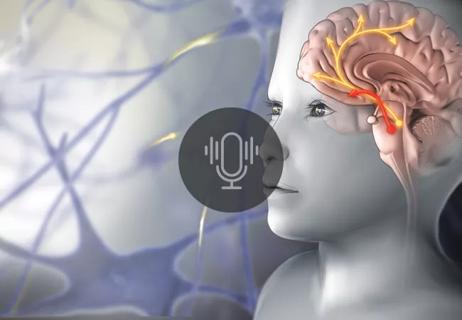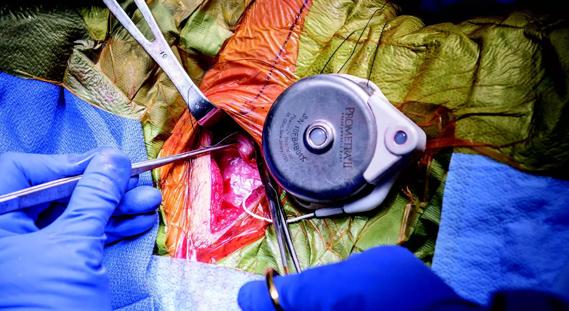Researchers identify the neurologic evolution of pain-related learning

When someone experiences unexpected pain, the brain generates a teaching signal to help avoid future pain and aid survival. Reinforcement learning theory refers to this signal as a “prediction error,” which is a mismatch between expectations and outcome. This prediction error signal, aversive in nature, helps us to learn avoid tasting food hot right off the stove. Similarly, unexpected absence of pain also teaches us to refrain from avoiding benign situations.
Advertisement
Cleveland Clinic is a non-profit academic medical center. Advertising on our site helps support our mission. We do not endorse non-Cleveland Clinic products or services. Policy
When this process works well, it helps us better navigate life. When pain processing goes awry, however, the source can be hard to find.
With an eye toward enabling better treatment for patients with chronic pain, researchers at Cleveland Clinic are studying the neurophysiologic encoding of aversive prediction errors. For the first phase of their research, published recently in the journal Pain, the team combined an instrumental pain-avoidance task with computational modeling and magnetoencephalography (MEG) to detect dynamics that underlie pain avoidance behavior in the brains of healthy participants.
“We aimed to identify signals that track aversively signed prediction errors in the brain along a continuum from the best case (unexpected pain avoidance) to the worst case (unexpected pain),” says first author Raghavan Gopalakrishnan, PhD, a pain researcher at Cleveland Clinic’s Neurological Institute. “Such a signal is central to adaptive behavior, since it reinforces actions that avoid pain and penalizes those that do not.”
Understanding these mechanisms in healthy brains will allow researchers to identify differences that become evident in participants with chronic pain. The second arm of the study will analyze the same process in those with complex regional pain syndrome.
MEG is crucial to the work.
“MEG can identify the brain regions that encode prediction errors after experiencing pain or pain absence with precise timing. A lot of studies use functional magnetic resonance imaging (fMRI), but the signals recorded by fMRI are indirect and lagged, so we don't know exactly at what point in time the activity happened,” says Dr. Gopalakrishnan. "Further, MEG signals can be decomposed into spectral bands to discern which frequencies are involved in encoding the prediction errors.”
Advertisement
This study was performed by Dr. Gopalakrishnan in collaboration with leading pain neuroscientists, including Tor Wager, PhD, of Dartmouth University and Mathieu Roy, PhD at McGill University. Drs. Roy and Wager have previously studied aversive prediction errors using fMRI, published in the Nature Neuroscience (2014).
The study yielded data for 27 healthy adults who each performed an instrumental pain-avoidance task. The task entails learning probabilistically changing cue-pain contingencies to avoid receiving a pain stimulus outcome.
“The task was adopted from a gambling task, where the outcomes are generally represented by monetary loss or gain,” says Dr. Gopalakrishnan. “However, in our task, the outcomes were pain, which is akin to loss, or absence of pain, which is akin to gain. The probabilistic nature of the task ensured the participant’s brain generated prediction errors on every single trial, i.e., they can never predict the outcome with 100% certainty.”
While they performed the task, the participants were seated in the MEG scanner. Pain was delivered to the thumbnail bed using a pressure pain device, with pain levels carefully calibrated to individuals' pain tolerance levels. Computational reinforcement learning models were then applied to the participants’ decisions and outcomes received during the task.
"Computational models are very powerful tools to infer mechanisms underlying latent processes such as learning and decision making. Regressing the computationally derived estimates of prediction errors onto neurophysiological data could unveil latent brain processes. That’s exactly what we did,” says Dr. Gopalakrishnan. “We further employed a set of axiomatic principles that define aversive prediction error signals, making our approach very rigorous.”
Advertisement
Important results from the research map to each of the three elements the researchers were studying pertaining to aversive prediction errors:
Chronic pain, specifically nociplastic pain syndromes — pain not tied to nociceptive or neuropathic causes — is increasingly viewed as a learning impairment. While adaptive learning and pain avoidance aids in survival, impaired pain avoidance stems from maladaptive learning such as attributing excessive threat value to pain and attributing excessive safety value to the absence of pain. This results in avoidance of safe cues and valued life activities, such as walking, exercising or even socializing.
“Given that prediction errors are central to learning, our goal is to understand when, where and how prediction errors are encoded in the brain and how they differ between pain-free and chronic pain individuals,” says Dr. Gopalakrishnan.
These factors are also critical for developing neuromodulation as a potential intervention for chronic pain.
“This information will help us to target specific areas of the brain at specific frequencies,” says Dr. Gopalakrishnan. “If, for example, the alpha band is involved, we can enhance or suppress the alpha band and see if that fosters adaptive behavior.”
Advertisement
The hope is that studying prediction errors in people with chronic pain will help locate the source of patient suffering in the brain.
“The brain can make wrong associations,” says Dr. Gopalakrishnan. “If we find evidence for the involvement of a different frequency band in patients than in healthy controls, or if a different brain region is involved, or there is an overall shift in the timing of prediction error generation, we could attempt to modulate them. Ultimately, our goal is to find novel therapeutic solutions to mitigate the effects of chronic pain and improve patients' quality of life.”
Advertisement
Advertisement

Researchers seek solutions to siloed care, missed diagnoses and limited access to trauma-informed therapies

Cleveland Clinic study investigated standard regimen

Tapping into motivational interviewing to guide behavioral change

Self-efficacy mindset, burst therapy and increased biofeedback may help improve outcomes

How functional restoration can help children with these conditions marked by unexplained pain with stigmatized symptoms

Two-hour training helps patients expand skills that return a sense of control

National Institutes of Health grant supports Cleveland Clinic study of first mechanism-guided therapy for CRPS

New technologies and tools offer hope for fuller understanding